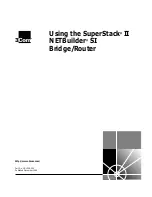
Handling Fiber and Fiber Optic Connectors
Network Interface (NI) Modules
page 5-36
OmniSwitch 8800 Hardware Users Guide
December 2004
Keep Your Fiber Optic Connectors Clean
Unlike electrical connectors, fiber-optic connectors must be extremely clean in order to ensure optimum
system performance. Microscopic particles such as dust on the connector endface (i.e., where the light
exits the connector) can degrade the performance of your system, often to the point of failure.
If you have low-power output from a fiber-optic transceiver or a fault signal from your equipment, begin
the troubleshooting process by cleaning your fiber-optic connectors per manufacturer recommendations.
Keep the Transceiver Interface Clean
If you have cleaned your connectors, but still experience low-power output from a fiber-optic transceiver
or a fault signal from your equipment, you should clean the transceiver interface by blowing inert dusting
gas inside the transceiver interface. This removes dust and other small particles that may block the optical
path between the optics of the transceiver and the connector’s endface.
Attenuate Properly
Often, equipment using laser-based transceivers need to have the optical path attenuated when performing
loop-back testing or testing between two pieces of equipment. Too much optical power launched into the
receiver will cause saturation and result in system failure. If you are using single mode fiber and you do
not know the power output of the laser, it is always best to use a 10 dB attenuator when testing. Using the
wrong type of attenuator will introduce problems, most notably reflection of light back into the laser, often
resulting in excess noise and causing system failure.
Inline attenuators eliminate the need for additional jumper cables and thus reduce the number of connec-
tion interfaces. This increases the integrity of the optical path resulting in a more accurate test.
















































